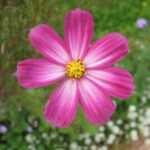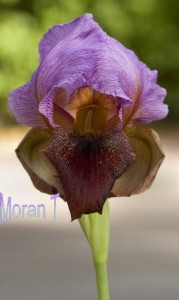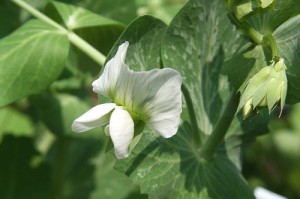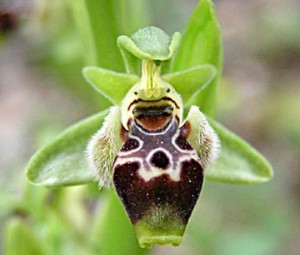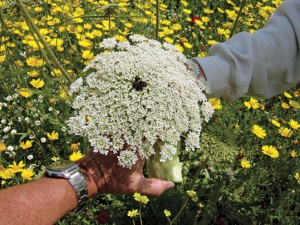Purim Costumes for Flower Flirts
In a classic Nafoch Hu, Purim transformed our summer-in-the-winter into a rainy, stormy Purim, just like it should be. And like a Purim costume that makes us feel a little different for just one day, the winter-disguised-as-a-heat-wave wasn’t really summer, and the earth didn’t really dry up. Instead, one passionate bout of rain filled the farm with giant gay puddles, revealing that under that deceiving summer cloak, wintry drenches and mud would emerge to create one sticky, swampy place. We’re now gearing up for some very muddy harvest days ahead.
In honor of Purim, I collected some Purim spiel from previous newsletters, about costumes and tricks played by Mother Nature.
Flowers and animals dress up in nature all year long. They long ago discovered the power of imitation and make-believe. Contrary to the notion that a costume is only skin-deep, there are cultures, especially ancient ones, that consider dressing up and sporting masks to be powerful tools for gaining the preferred traits of the character they impersonate. Flowers prove the worth of this theory, big time. They dress up in a variety of beguiling ways and play a host of tricks to hit their very clear aim: the pollen, or rather, the fertilization. I mean, of course, seeds and continuity. Here are some of their schemes:
Some flowers choose costumes from the queen/princess/bride genre, so adored by girls of a certain age (and their proud mamas). They adorn themselves in pink angelic muslin and lace fluttering in the breeze, as if to say, “Hey, look me over, oh handsome butterflies (or flies/bees and other gnats… whatever is flying). Catch how pretty I am, how sensitive, how ladylike. Definitely worth a visit— perhaps a kiss?
Other flowers opt for the “super-hero” genre (Superman, Spiderman, etc.). They’re bereft of nectar themselves, but they dress up as their nectar-laden cousins in order to attract insects to drink from them–and if the insects just happen to pass some pollen on the way, would they mind terribly fertilizing them by pollination? There are some beautiful orchids, which are actually impersonators. The Iris group Oncocyclus (royal iris) employ the same tricky technique.
Sometimes flowers don’t imitate their brothers, but rather the insects. The underlying psychological motive is that the insect, too, is searching for love. If a flower tricks the insect into thinking she’s his beschert, surely he will swoop down on the flower and ride off into the sunset. Take a look at the photos, and see if even you are confused:
The Fabaceae flower look like a butterfly (they are also known as Papilionaceae, from the French word for “butterfly”)
The Ophrys (“Bee orchid”) looks just like a bee:
And the Daucus carota flower appears to be proudly flaunting a good-looking fly in the centerfold, just waiting for Prince Charming Fly to pay a visit:
May we all have a happy and cheerful week, carefree and filled with fun.
Alon, Bat Ami and the Chubeza team
________________________________
This week’s basket includes:
Monday: cucumbers, cilantro, potatoes, parsley root, carrots, tomatoes, broccoli, celery, daikon, kohlrabi, green garlic or green onions
In the large box, in addition: cauliflower, fava beans, parsley
Wednesday: broccoli, tomatoes, parsley, parsley root, daikon, kohlrabi, peppers, green garlic, carrots, cucumbers, celery.
In the large box, in addition: cauliflower, cilantro, fava beans
______________________________
Recipes for the Return of the Winter:
Lobsong’s Thantuk Soup
(As requested by Michal)
Ingredients:
- Oil for frying
- One bunch scallions (the bulbs)
- Parsley root and celery root (most essential—these are the main seasonings)
- Daikon
- Tomato
- Your choice of additional hard winter vegetables: kohlrabi, carrot, potato, etc.
- Add leaves, if desired: turnip, daikon and radish leaves best enhance Lobsong’s soup.
- If these varieties aren’t available, others can be substituted, but relatively coarse leaves such as kale or Swiss chard are best.
- Lamb bones (optional)
- Approx. ½ kilo flour
- Water
- Salt
- Soy sauce/vinegar
- Chopped scallions (the green part)
Preparation:
- Chop all the vegetables into relatively small pieces
- Heat oil on high flame, add chopped vegetables, cover with chopped leaves, and stir-fry for around 10 minutes until vegetables just become soft.
- If using lamb bones, add them at this point.
- Add water and bring to a boil.
- Prepare dough: Mix flour and water to form a firm, but workable dough. Yield should be around 400 grams of dough. Roll into 4 or 5 hotdog-diameter strands. Using oiled hands, stretch and squeeze each strand repeatedly till achieving a long, 4-cm. wide noodle.
- When vegetables are soft and the soup is almost ready, clip the noodles to 3-cm. lengths, using your fingers. Add to boiling soup, and continue cooking soup and noodles for an additional 2-3 minutes before removing from flame.
- To serve: Drizzle several drops of soy sauce or vinegar, according to taste, and sprinkle soup with chopped green onions.
Ruti from Jerusalem requested suggestions for using the celery that’s been accumulating. In such a case, I usually prepare celery marinades such as these two recipes:
Marinated celery, hellenic style
And two more hearty options from your box this week:


